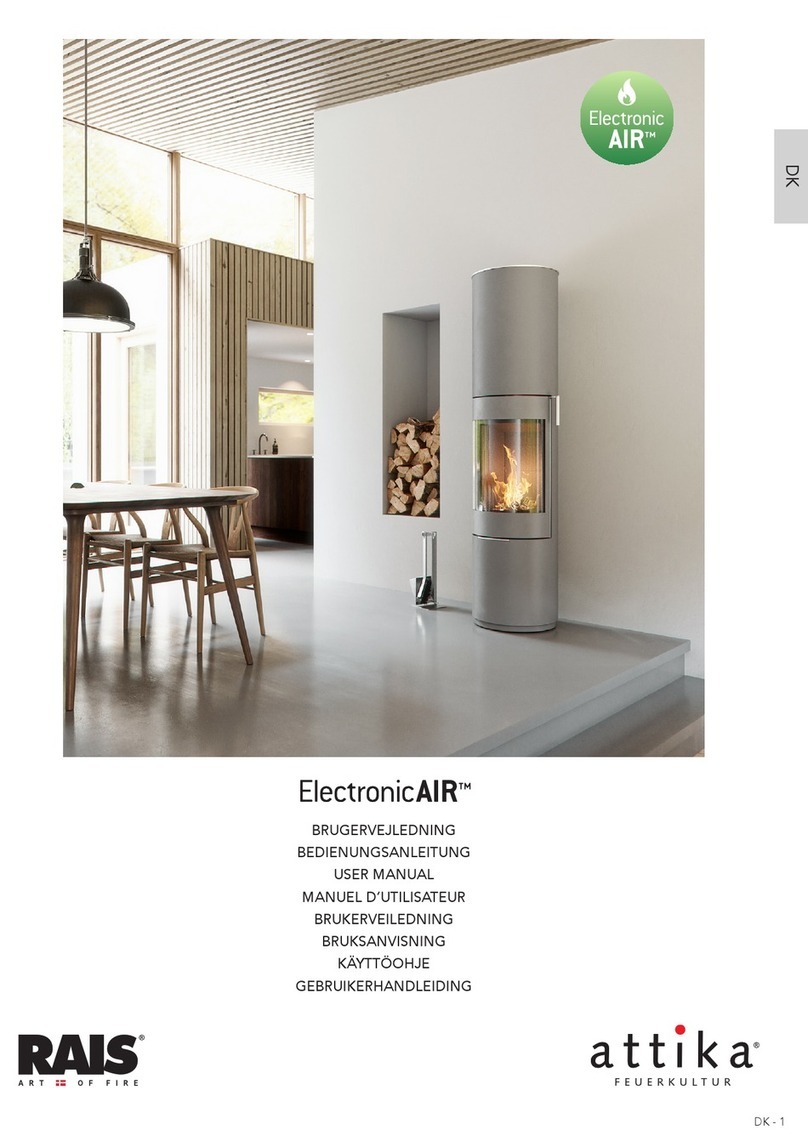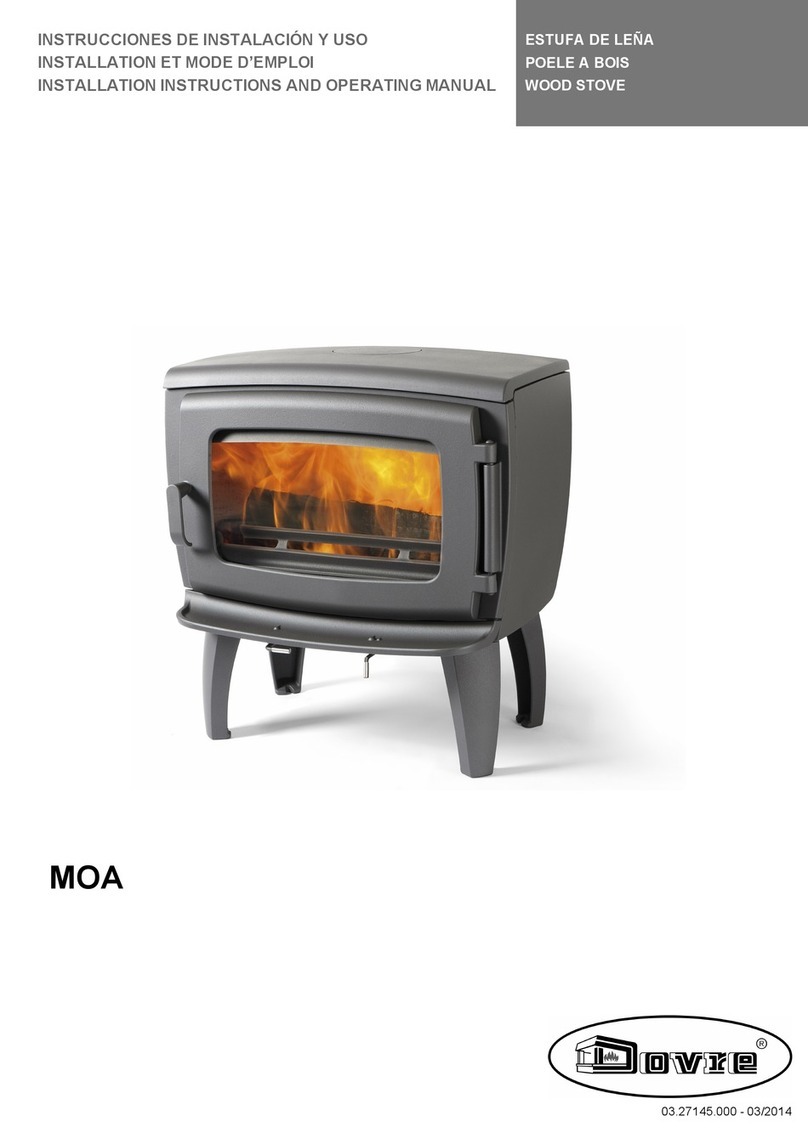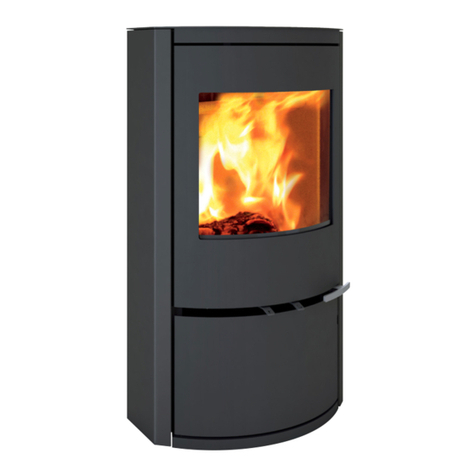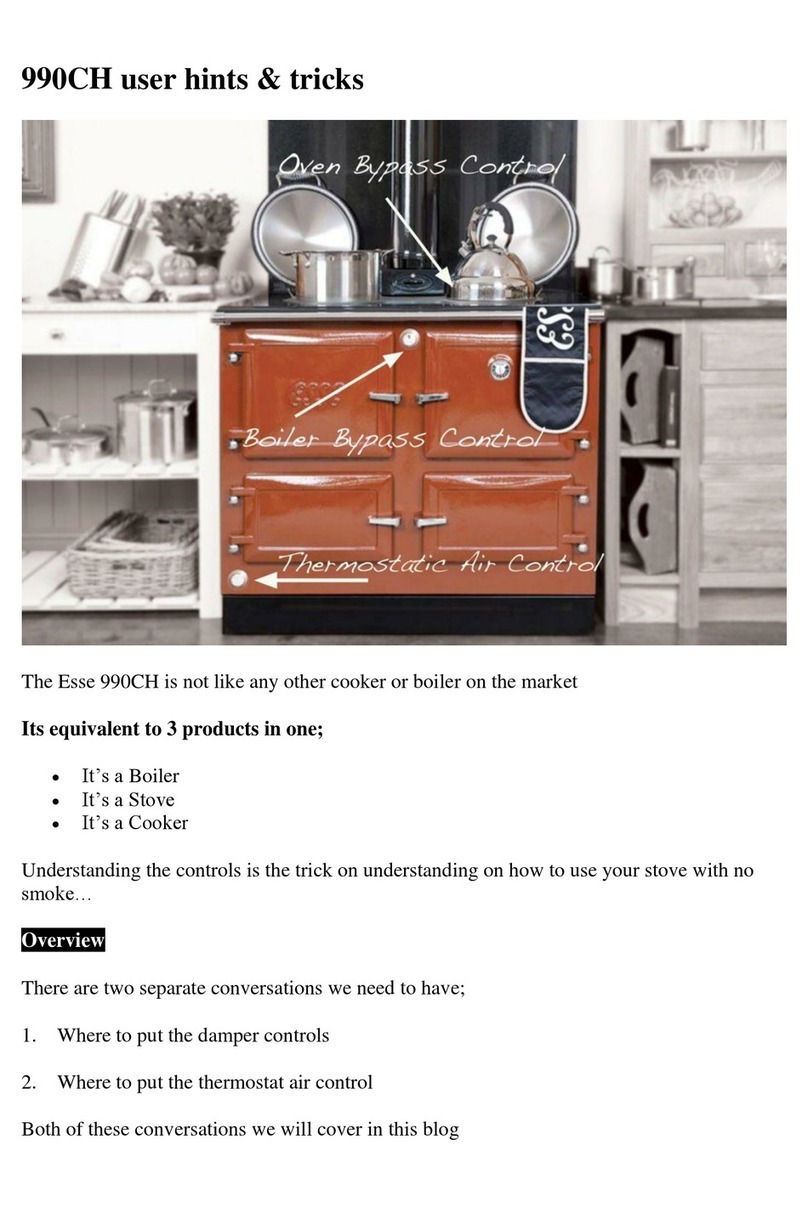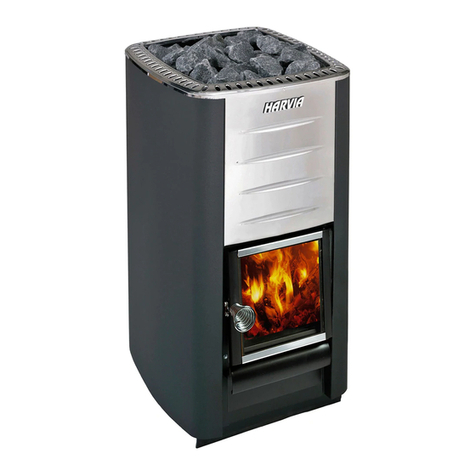TMF Valerian User manual

Valerian
Wood-Burning Heating Stove
Made in Russia
Operating manual

Heat better. Works longer.
Thank you for purchasing our goods.
This operating manual describes operating principles and provides
operating and maintenance instructions for Valerian wood-burning
heating stove (hereinafter—the stove), as well as instructions for its safe
and proper use.
Installation and operation of the fireplace should be performed by
persons, who read and understood the guide.
The document is copyright-protected. Reproduction of the document, in part or whole, is prohibited
without prior written permission from the manufacturer.
The manufacturer reserves the right to make changes in the design of the fireplace that do not
impair the fireplace's operation qualities, at any time and without updating the supporting documents.
Contents
1. Intended Use
Page 27
3. Product Range
4. Specifications
5. Stove Construction
8. Maintenance
6. Marking and Packaging of the Fireplace
9. Routine Maintenance
10. Storage
12. Disposal
11. Transportation
Page 42
Page 43
Page 43
44
Page 44
45
7. Operation Page 30
Page 29
Page 41
Page 27
Page 29
14. Delivery Package
Page
Page
26
13. Warranty
Page 27
2. Construction Features
Page 27

27
1. Intended Use
Valerian wood-burning heating stove is designed for efficient air
heating of residential and non-residential premises that temporarily
attended by people.
The stove can operate at a temperature from -60 to +40 °C at moder-
ately cold climate (UKhL climate conditions) with placement category 3
according to GOST 15150-69.
2. Construction Features
nTrusted classic design of a prolonged burning stove.
nConvection pipes for fast and even heating of premises of up to
330 sq. m.
nSide panels reduce radiation and increase convection.
nSealed door of original design with a translucent screen.
nValve for burning intensity adjustment.
3. Product Range
The batch production includes Valerian stove models with the power
capacity of 8, 15 и 20 kW.
4. Specifications
Specifications of each models are provided in table 1. Overall
dimensions of the stove are provided in figure 1.
Permitted types of fuel: firewood.
Caution! The stove should only be used with the specified fuel types.
Caution! The use of coal and coal briquettes is strictly prohibited.
Caution! The maximum volume of the heated room is calculated based on
effective heat exchange and regulations for overall heat-
transfer resistance of enclosure structures according to SP
50.13330.2012 or as per regulations effective in the country
where the stove is used.

28
Table 1. Specifications
Model Valerian
Maximum volume of the
heated room, m3 130 230 330
Maximum power, kW 8 15 20
Overall dimensions of the stove
А, mm 535 615 615
В, mm 620 690 800
С, mm 655 750 750
D, mm 460 540 540
Weight, kg 54,5 71 87,4
Size of the fire door, mm 295 295 295
Firing chamber volume, L 35 52 65
Maximum load of
firewood, L 26 46 59
Maximum length of a wood piece, mm 395 462 576
Flue diameter, mm 120 120 120
Recommended flue height, m 5 5 5
Convective pipes:
diameter, mm / number, pcs 57/7 57/8 57/10
Fig. 1. Overall dimensions of Valerian
Ø120
В
С
А
D

29
5. Stove Design
Location of main elements of Valerian stove is shown in Fig. 2.
Firebox (7) of the Valerian stove is made of 3-millimetre structural
steel. The stove consists of furnace chamber with convection pipe system
(1) installed around it. The surface of the convection pipes efficiently
transfers heat to the bearer (air) that circulates inside the pipes.
The furnace is covered by the convector panels (8).
The deflector (6) separates the firebox from the flue connection.
The door (2) of the furnace chamber has a window with the translu-
cent screen (3), and sealing along its perimeter (expendable material).
The turning handle of the latching mechanism secures the door in the
closed position by turning the handle down.
When you fire the stove, the secondary air required for burning is
supplied to fuel through the air control valve (4) located at the door. For
fire safety the valve is covered with the deflector (5) from the furnace
side.
By regulating the valve (4), you can force the burning and obtain a
strong high-temperature flame at the moment of firing.
The stove external surface is covered by organosilicon heat-resistant
enamel.
Caution! The manufacturer reserves the right to make changes in stove
construction that do not impair the stove operation quali-
ties, at any time and without updating the supporting
documents.
Combustion gases are transferred to the flue (flue pipe) through the
flue outlet with a diameter of 120 mm, located at the back wall of the
stove.
6. Marking and packing of the stove
6.1. Marking
There is an information label indicating the model of the stove, its
mass, factory serial number and date of manufacture of the stove, as well
as information about the certificates for this model.
6.2. Packaging
The stove is packed in transporting packaging. User manual (in a
plastic bag) and accessories are enclosed in the burning chamber.

30
Front side of the stove packaging there is a label that contains
information about the model of the stove, its weight, design features and
date of manufacture.
6.3. How to remove packaging:
1. Cut and remove packaging tape.
2. Remove polyethylene.
3. Take user manual and accessories (if any) from the stove and
remove packaging from them.
4. Remove bars by untwisting fastening bolts (if any). Remove all
stickers and protective film from the stove
7. Suitable application
7.1. Preparing the stove for exploitation
Caution! It is prohibited to use the stove in production facilities of
categories A, B, B1-B4 for fire and explosion safety in
accordance with NPB 105-03 (Definition of the category of
buildings, structures and premises for fire and explosion
hazards).
Caution! Do not use alcohol and flammable compounds to light up the
stove.
Caution! It is not allowed to burn glossy paper, chipboard, laminate and
hardboard trimming, as this can generate gases that can
cause an explosion-like ignition.
Caution! When the furnace is first heated, acrid smoke and smell may
appear, which disappear during further operation.
Caution! It is forbidden to overheat and make the stove red hot during
operation. Overheat can be identified by the red glow of the
metal of the stove's heater in the dark, especially the element
of the chimney pipe.
People with lung diseases and pet owners who are susceptible to
smoke should take precautions.
The first heating of the stove should be done outdoors with fire
safety precautions taken, until the smoke and acrid smell disappear (at
least 1 hour), when the firebox is half loaded in the intensive burning
mode. Make sure that the unpleasant smell of the enamel has completely

31
1
2
3
4
5
6
7
8
Fig. 2. Location of main elements of Valerian stove
1 - Convection pipes
2 - Door of the furnace chamber
3 - Translucent screen
4 - Air control valve
5 - Deflector
6 - Deflector
7 - Firebox
8 - Convector panels
Pictures of the product shown in this Operating Manual may differ from the actual
product the manual is supplied with.

32
worn off. Ensure that there are no more vapors and odor from the
paintwork.
For the stable operation of the stove during the first heating it is
necessary to organize a temporary chimney with a height of at least 2 m.
Caution! To avoid damage to paint during the first heating, do not apply
any mechanical influence to the surface of the stove until it
cools down completely and the paint is completely polymer-
ized.
Caution! The first heating should be performed with open door to
prevent scaling on the transparent screen.
Make sure all the elements of the stove and protective constructions
are functioning correctly. The stove can't be used in case it has any
malfunctions.
Correctly working stove:
ndoes not have casing damage,
n the door rotates freely on hinges and is securely locked in the
closed position,
nThe door hollow has a sealing cord fixed along the entire
perimeter.
nThe glass of the door is free of cracks, chipping, and other
damages.
nAir control valve flap moves freely and tightly seals the channel
when closed.
7.2. Preparing the room for the stove installation
The stove should be installed in the room, which requires heating.
Structures of the room, which are located at the distance of less than 500
mm from stove and flue pipe, are to be protected from ignition as follows:
nWalls and partitions of inflammable materials should be
covered with 25mm of plaster on a metal grid or with a metal
sheet on 10mm of a fireproof heat-insulating material
nUnder the stove, it is necessary to make a base of brick or other
fireproof material or a pedestal platform made of fireproof
material 100 mm high from the level of the wooden floor. The
dimensions of the base must be such that the minimum distance
from the stove to the edges of the base is at least 380 mm. There
is no need in any additional pedestal if the stove is installed on
the fireproof floor.
nThe floor of flammable and hardly-flammable materials in front

33
of the firebox door should be covered with a metal sheet of
700×500mm (Fig. 3).
nThe ceiling part where the chimney pipe goes through must
have a fireproof cutting.
Caution! The place where the stove and the chimney are installed must
be equipped according to the requirements of SP
7.13130.2013 or the technical standards of the country the
stove is used in.
Caution! The stove is heavy! The floor in the room in which the stove is
installed must comply with the requirements of SP
29.13330.2011.
Caution! It is necessary to ensure a constant flow of fresh air from
outdoors into the room with the working stove. Violation of
this condition can lead to unstable work of the stove and the
possibility of dangerous situations such as carbon monoxide
poisoning, fire, backdraft.
7.3. Mounting the stove
Caution! Install the stove and load the stones only after it is completely
cooled down.
Caution! The stove is heavy. Make sure that you have the skills and
equipment to move it.
Caution! It is forbidden to install the stove in places where it will create
an obstacle for the movement of people during evacuation.
Caution! Install smoke and gas detectors in the room where the stove is
installed.
Install the stove in a specially prepared place as described in p. 7.2.
Make sure that the stove is assembled and installed in accordance with
the requirements of SP 7.13130.2013 and this manual.
If, after reading this manual, you are in doubt about the correct
installation of the stove, you should get a consultation from a stove
installer who knows all aspects of fire safety and the rules for installing
stoves.
The stove installation scheme is shown in the fig. 3. The distance
from the stove door to the opposite wall should be at least 1250 mm. The
distance between the top of the stove and the unprotected ceiling should
be at least 1200 mm.
The distance between the external surface of the stove, the chimney

34
and the combustible structural elements of the room (building) should be at
least:
nfor unprotected structures made of combustible and hardly
combustible materials - 500 mm;
nfor constructions of fireproof materials - 380 mm;
nfor structures made of combustible and hardly combustible
materials protected according to p. 7.2. - 380 mm.
Do not install the stove in a passage, or near to a flight of stairs as it
may block evacuation in case of fire. Do not install the stove in a bedroom.
Do not install the stove into a recess in the wall (niche) or into a fireplace
furnace (or into a stone stove furnace).
7.4. Chimney installation
Caution! Usage of boiling type heat exchanger of any manufacturer is prohib-
ited.
Please pay special attention to the chimney while using the stove.
Chimney (flue pipe) — is a means of removing products of combustion,
it produces draft which provides constant air intake necessary for the
normal process of combustion. This stove is designed only for work on
natural draft.
The stove should have its own chimney.
Caution! It is forbidden to connect the stove to any ducts, except when the
duct is only intended to work as a chimney.
Caution! Do not connect the stove to the chimney, to which other heating
device is connected.
Caution! The stove does not generate draft. Draft is generated only by
chimney.
Draft is the natural movement of air or gases through the stove and the
chimney. It appears because warm air rises upwards.
As the warm air moves through the chimney, low pressure is created at
the connection of the stove to the chimney. Greater pressure outside the
stove causes the air to move into the area with less pressure - into the
combustion chamber. That is how the air comes into the combustion
chamber. This constant air flow is called draft.
The stove will not work effectively without a certain level of draft.
The optimal draft for the work of the stoves is 12 ± 2 Pa.
Excessive draft leads to increased fuel consumption and overheating of
the stove and chimney. There may be a risk of fire.

35
10mm metal sheet on fireproof
material
fireproof insulation material
(expanded clay/ slag / basalt wool)
bricks, etc. (fireproof material)
Wood (flammable material)
1 - Pipe cowl
2 - Finish sandwich
3 - Heat-insulated flue
module (sandwich)
4 - Ceiling with fireproof
roofing
5 - Ceiling divider
6 - Start sandwich
7 - Wall made of a
combustible material
8 - Stove base made of a
non-combustible
material
9 - Metal sheet applied to
asbestos paper to
protect wall made of
combustible materials
Fig. 3. Scheme of installing the stove
1200 min 70
500
380
1
5
3
7
8
4
6
2
1000 min
380
9
250
This diagram is a sketch showing the general recommended distances and developed in accordance with
the requirements of SP 7.13130.2013.

36
With insufficient draft, there won't be enough air for continuous and
complete combustion of fuel, which can lead to smoking of the room,
accelerated scaling in the chimney and the formation of creosote, which
is toxic and flammable. When installing the chimney, before attaching
the stove to it, it is necessary to check the presence of a draft in it.
The chimney must have a minimum number of elbows (bends).
Straight pipe is preferable. Using more than two elbows can lead to a loss
of draft and possible smoking of the room.
When installing the flue pipe in buildings with combustible roof,
equip the pipe with a spark arrester made of metal grid with meshes not
larger than 5x5 mm and cover the area around the pipe with a non-
combustible roofing material.
To securely fix the modules to each other, it is recommended to use a
crimp clamp.
The chimney must be securely fastened to the structural elements of
the building.
In the case of installing a thick-walled metal, ceramic or other
chimney of large mass, it is necessary to unload the stove from its weight.
Caution! The manufacturer is not responsible for the influence of
external factors on the reduction of natural draft in the
chimney.
Caution! It is forbidden to use single-walled chimneys with galvanized
coating.
Caution! Do not use pipes from different manufacturers in the same
chimney.
Caution! All the places of connection of the chimney modules with each
other and with the stove should be sealed with a heat-
resistant sealant (not less than 1000 ° C), ensuring tightness
of the pipe joints.
Please pay attention to the sealants manufacturer recommendations.
Some sealants can make unpleasant smell when overheated.
Caution! It is not allowed to join the chimney modules in floors and
sections.
Caution! The section of the chimney located in the zone of minus temper-
atures must be insulated with a fireproof material that can
withstand a temperature of at least +400 ° C.
The temperature of the flue gases in the section of the first chimney

37
module from the top of the stove may exceed the permissible operating
temperature of the insulated modules, so the first insulated chimney
module must be installed at a distance of not less than 1 m from the top
of the stove.
In the case of connecting the stove to a fixed built-in chimney, or in
other cases, it is not recommended to lean the axis of the chimney from
the vertical by more than 45 °.
Caution! Installation of the stove and the flue pipe should be performed
only by qualified personnel of a specialized construction and
installation company according to the requirements of SP
60.13330.2012 or technical standards of the country, where
stove is to be used.
Caution! It is strictly forbidden to connect the stove with a chimney or
other structural elements of the room in a way it can't be
disconnected afterwards.
Caution! In case of fire in the chimney, leave the building and immedi-
ately call the firemen.
7.5. Using the stove
Caution! Before lighting up the stove please make sure that there is a
draft in the chimney. in order to do so just take a lit match
to the open door of the stove, if the flame is drawn into the
stove it means there is enough draft.
Caution! To avoid injury, it is forbidden to use the stove by people
unfamiliar with the rules of the stove exploitation.
Caution! Check the furnace before igniting and, if needed, clean it from
foreign objects (unburnt coals, metal nails) left after the last
use. To prolong the service life, the manufacturer recommends
leaving a thin layer of ash covering the pipes at the bottom of
the furnace.
Caution! The stove should be operated only according to its intended use.
Caution! Do not use the stove in mobile homes, trailers, or tents.
Load the wood through the door. To ensure better ignition and air
supply to the burning area during ignition, do not lay the wood tightly,
open the control valve of the door and open the damper gate.
Laying the wood horizontally ensures even burning.
Do not load the combustion chamber to the top, as it can be

38
dangerous when the door is opened again. Always close the door after
lighting up the stove.
Caution! Do not burn wood in the fuel channel. This can lead to deforma-
tion of the door and fuel channel and the smoking of the
steam room.
Caution! Do not use the stove with open door. It can lead to dangerous
burning modes, smoke exhaust into the heated space and it
can cause fire.
Caution! Forced air blowing into the ash box is prohibited.
Ignite the wood at the top. Add woods to the furnace in small
batches. During ignition the firebox is to be filled with medium and
finely chopped wood. The larger pieces of wood should be put in the
bottom layer, the smaller pieces - in the top layer. Put chips on the top of
the wood for ignition. The furnace should be filled up to 2/3 maximum.
It takes some time for the stable draft to appear after the stove is lit
up. That is why when you open the door of the recently lit stove,
operating in set temperature, a slight output of smoke in the room is
possible to appear.
Further intake regulation, which affects combustion intensity, is
done by opening and closing the ash box. You should find how to regulate
the ash box correctly by experimental way.
To load a batch of wood, open the damper gate (not included into
delivery package) and close the valve of the door (in this order only);
slowly open the top door in a few seconds.
Be careful not to extinguish the fire while loading additional fuel.
To complete the stove operation, wait until the fuel is completely
burnt and then clean the stove from the ash, close the doors, the valve at
the bottom door, and the damper.
Caution! It is forbidden to flood the fire with water.
Caution! Never use a stove if its flue is damaged!
Caution! Usage of firewood with moisture level of 20% and higher leads
to higher scaling and excessive smoking.
Caution! During operation of the stove, slight deformation of the metal in
the stove is possible, which does not violate the tightness of
the welds - this is not the sign of reject.

39
7.6. Typical malfunctions and troubleshooting
7.7. Safety measures for stove exploitation
Prior to the start of the heating season, the stove, gas burner and
chimney must be inspected and, in case of faults, repaired. Gas sauna
stove is not allowed to be used in case it has any malfunctions. See p. 7.1
for signs of properly working stove.
Caution! It is forbidden to leave a heating up stove unattended, and
entrust supervision of it to young children and persons
under the influence of alcohol, drugs, medicines, etc.
Caution! Do not touch the heated surfaces of the stove with bare hands
or other exposed parts of the body to avoid burns and
injuries.
Caution! Do not place flammable substances and materials closer than
Trouble type
Disturbance of a
burning process
Emergence of
fuming
Emergence of
smell
Drops on an
external surface of
a tube
Slow heating of a
premise
Burnout of the fire
bar and (or) side
walls
Possible cause
Chimney draft has
deteriorated
Chimney draft has
deteriorated
Evaporation of remains
of oils and volatile
components of enamel
Insufficient
impermeability of joints
of chimney
Insufficient heat
insulation of a premise
Incorrectly selected stove
Have used a fuel with
high burning
temperature
Overheating of the stove
Troubleshooting
Clean the chimney
Clean the chimney
Preheat the stove in
accordance with point
8.2. in a place of
installation with
maximum ventilation of
a premise
Densify joints with heat-
proof sealant
Make warmer a premise
Select a stove of higher
power
Repair or replace the
stove, thereafter, use
recommended fuel

40
0.5 m from the casing of the stove.
Caution! To avoid accidental contact with the hot stove, it is
recommended to make fences made from non-flammable
material in the form of a grid or cage, and wear protective
clothing, protective (fireproof) gloves and goggles while
kindling the stove.
Caution! It is forbidden to build a solid fence around the stove which
prevents free convection air flow.
Caution! It is prohibited to dry clothes even on partially cooled surface of
the stove.
Caution! The release of carbon monoxide into the room is deadly.
Carbon monoxide is colorless and odorless, it is a product of combus-
tion of wood, coal, oil, gas and other combustible substances. It is very
important to have a good draft and a reliable ventilation system, which
allows to remove the combustion products through the chimney.
Caution! Install smoke and gas detectors in the room where the stove is
installed.
Sensors should be installed at a distance from the stove, preventing
false triggering. When installing, operating and maintaining gas sensors,
follow the manufacturer's instructions.
In case of an alarm (triggering of a carbon monoxide sensor):
nImmediately move to fresh air.
nCall the fire service or emergency service.
nAfter making the call, look around to make sure everyone has
evacuated the hazardous room. Do not return to the room until
fire-fighters or emergency service personnel allow you to do so.
If you return, you may black out and die.
nIf the source of the carbon monoxide is a malfunctioning
device, do not use the device until professionals check it.
Caution! If you have heard the alarm signal of the leakage detectors for
household gas and carbon monoxide, do not try to find the
source of gas!
Under any circumstances do not change the air supply system to the
combustion chamber to increase the burning intensity. The use of a boost
and / or other deviations from the designed system of air supply to the
stove create dangerous operating conditions.

41
Caution! Place power cables and electrical equipment in a safe area.
Caution! In case of ignition of creosote and/or soot in the chimney, it is
necessary to leave the room and call the firefighters.
Open and close the door only with a handle. The ash scraped from
the combustion chamber should be hydrated and removed to a special
fireproof ash container and hydrated again.
8. Maintenance
Caution! Cleaning and maintenance of the stove can't be performed until
the stove completely cools.
8.1. Stove and chimney maintenance
In order to provide fully effective and safe exploitation of the stove
the stove and chimney should periodically go through a technical mainte-
nance.
According to the "Rules of the fire prevention regime in the Russian
Federation", it is necessary to clean chimneys and stoves (boilers) from
soot before the start, and also during the entire heating season, at least:
nOnce every three months for heating stoves;
nOnce every two months for stoves and fireplaces of continuous
action;
nOnce a month for kitchen stoves and other stoves of a contin-
uous (long-term) loading of fuel.
When operating the stove outside the Russian Federation, it is
necessary to follow the technical standards of the country the stove is
used in.
It is preferable to hire qualified specialists to inspect and clean the
chimneys.
Caution! The manufacturer is not liable for the consequences of unskilled
cleaning and inspection of the chimney or stove.
Chimney must be cleaned mechanically (using special tools, brushes,
plumbs, scrapers). The brush is selected depending on the shape, dimen-
sions of the pipe cross-section. Chemical cleaning of the chimney can be
done as a maintenance measure. Chemical cleaning of the chimney does
not replace its mandatory mechanical cleaning and is not the main
method of cleaning the chimney and the stove.
Caution! Carefully read the instructions and follow the recommendations
of the manufacturer of chemical cleaning agents. It is forbidden

42
to use self-made compounds for removing soot.
Caution! Take necessary precautions to protect the eyes and respiratory
system from dust and soot during mechanical cleaning of the
chimneys.
Caution! Disconnect the stove from gas pipes during flue cleaning in order
to prevent their clogging.
8.2. Transparent door screen maintenance
In order to prevent ash accumulation on the translucent screen
(glass), clean it regularly.
Accumulation of acidiferous layer (ash) will corrode and wear down
the glass translucent screen.
To make the glass last for a long time, you should follow the
following rules.
Regularly inspect the glass for cracks and chips. If you found one,
immediately extinguish the stove and contact the stove manufacturer to
decide whether to replace the glass.
Do not slam the door, do not hit the glass in any other way. Make
sure logs and other objects do not protrude from the combustion
chamber and can't damage the glass while closing the door.
Do not make a fire near the glass, or in a place where it may be near
the glass during the burning process.
Do not use materials which can scratch or damage the glass while
cleaning it. Scratches on the glass can eventually lead to its destruction.
Never clean the glass while it is hot. The glass should be completely
dry before lighting up the stove.
Never put substances into the stove which can ignite explosively.
Even a small explosion in a closed space can knock out glass.
Clean the glass from soot with a soft mop with a special compound
for stove and fireplace glasses according to the manual of such
compounds.
Use of the stove with a damaged transparent screen is prohibited. If
the glass is damaged it should only be replaced with 4mm heat-resistant
ceramic glass of the original size.
Do not use tempered glass or thick window glass. Contact the manu-
facturer to replace the transparent screen.
9. Repair
The sealing cord in the firebox door and the ash box door wears out
during operation and therefore its sealing properties deteriorate. The

43
manufacturer recommends cord replacement at a regular basis. The
wear is not covered by the warranty.
Paint cover damage can lead to corrosion of the stove surface, it is
not a warranty case. In order to prevent this manufacturer recommends.
In order to prevent this, the manufacturer recommends that the case is
tinted using heat-resistant silicone enamel. For the convenience of tinting
it is possible to use enamel in aerosol cans.
10. Storage
The Product should be stored packed under the conditions specified
in GOST 15150-69, category 3 (closed rooms with natural ventilation and
without climate control) at a temperature from -60 to + 40 °С and relative
humidity not more than 80 % (at +25 °С).
The air of the storage room should be free of aggressive substances
(acid vapours, alkali).
The storage requirements apply to the warehouses of the Supplier
and the Customer.
The period of storage in the retail package without re-conservation
should not exceed 12 months. If the fireplace is stored at high humidity,
its painted surfaces may show signs of surface corrosion, which does not
affect the fireplace operation characteristics.
11. Transportation
11.1. Transportation Conditions
The product can be transported in shipping package by any means of
transport (including heated pressurised compartments of planes without
any restrictions to travel distance). The product can be shipped by rail as
a small LTL shipment.
The product should be protected from dust and weather conditions
during transportation. The product should not be turned over during
transportation.
11.2. Preparation to Transportation
Before transportation, the products should be fixed in a secure
position to avoid movement and hitting.
Requirements of the handling symbols printed on the package
should be strictly followed during the products handling and transporta-
tion.

44
12. Disposal
When the fireplace service life ends or if the fireplace fails (as a
result of incorrect use) and cannot be repaired, the fireplace or its
components should be dismantled and disposed.
While disconnecting the fireplace or its elements from the flue,
ensure eyes and respiratory protection from dust and soot which accu-
mulate in the system during operation.
Caution! The system may be dismantled only when it has completely
cooled down.
The product is free of dangerous and poisonous substances, which
may harm people or pollute environment, and poses no hazard to human
life, health, and environment after its service life. Thus, the product can
be disposed according to the rules of disposal of general industrial waste.
13. Warranty
The warranty period of the stove (hereinafter referred to as “the
Product” in the text of this section) is 12 months from the date of delivery
of the Product to the Consumer. Some assemblies and components of the
Product may have longer warranty period (including those with a
specific note in Acceptance Certificate and Warranty section of this
Manual).
Warranty liabilities do not cover parts that are subject to normal
wear (protection screens, protection flue liners, clay firebricks etc.).
Quality assurance is not applicable to these parts (paragraph 3, Article
470 of the Civil Code of the Russian Federation).
If the Consumer detects non-conformance of the Product to specifica-
tions stated within the warranty period, it has a right submit a claim to
the corporate manufacturer of the Product (the Manufacturer). If the
non-conformance of the Product or its assembly/component detected
within the warranty period was caused due to the fault of the
Manufacturer, the Consumer has a right to require correction of the
detected non-conformance including repair of the Product at the expense
of the Manufacturer.
The Manufacturer's repair of the Product may be performed by
means of repair or replacement of defective component. However,
replacement and repair of defective parts that can be dismantled
according to the design of the Product and removed from the
Product/mounted on the Product by the Consumer unaidedly (e.g. heat
exchanger etc.; hereinafter - “removable parts”) shall be performed
Table of contents
Popular Wood Stove manuals by other brands
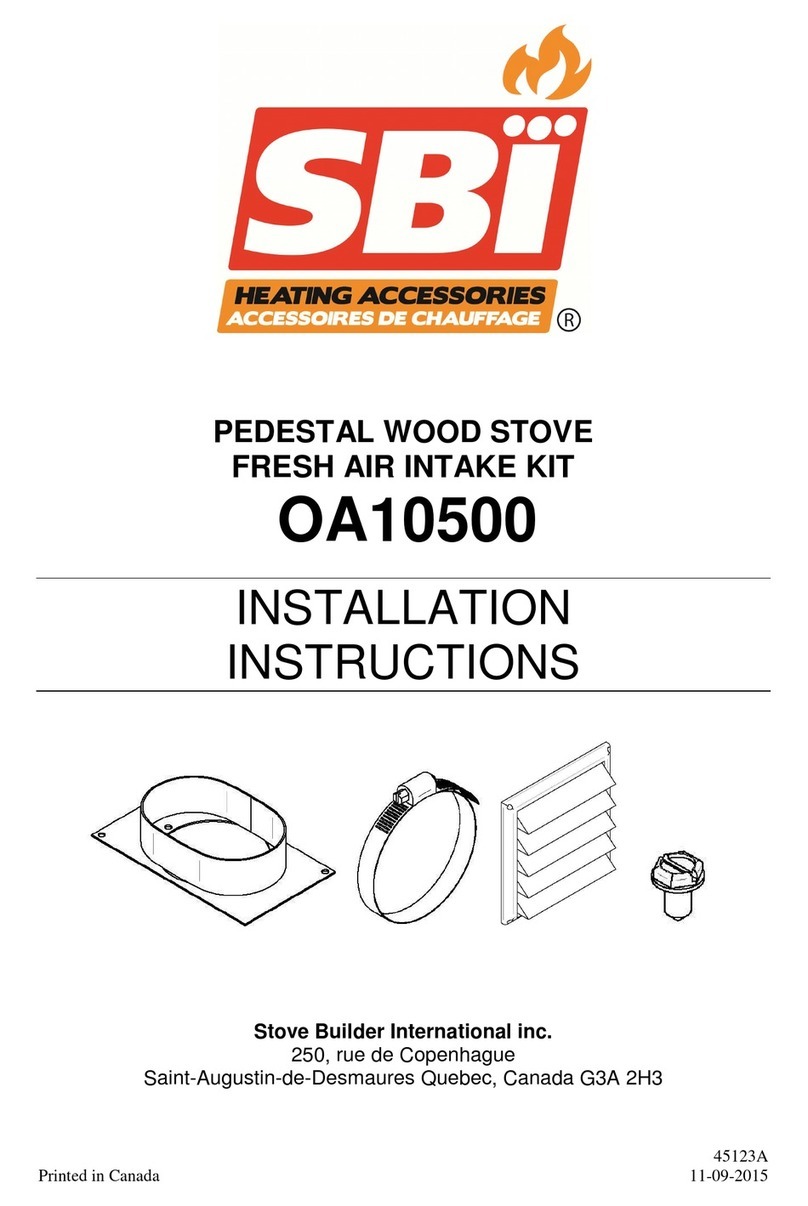
Stove Builder International
Stove Builder International OA10500 installation instructions
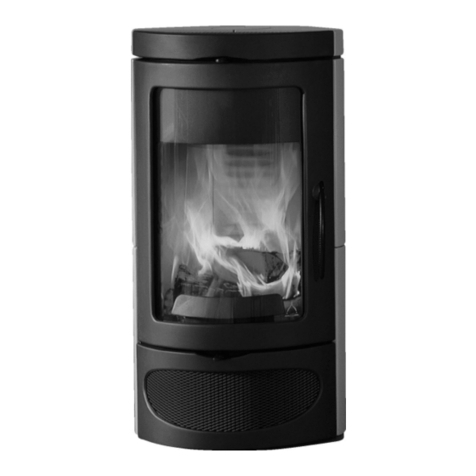
Austro Flamm
Austro Flamm VITA manual
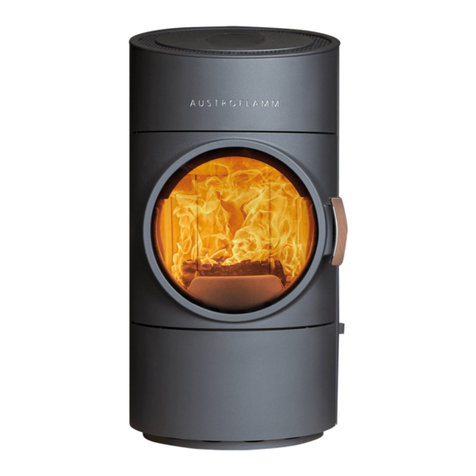
Austro Flamm
Austro Flamm Clou Compact 2.0 operating manual
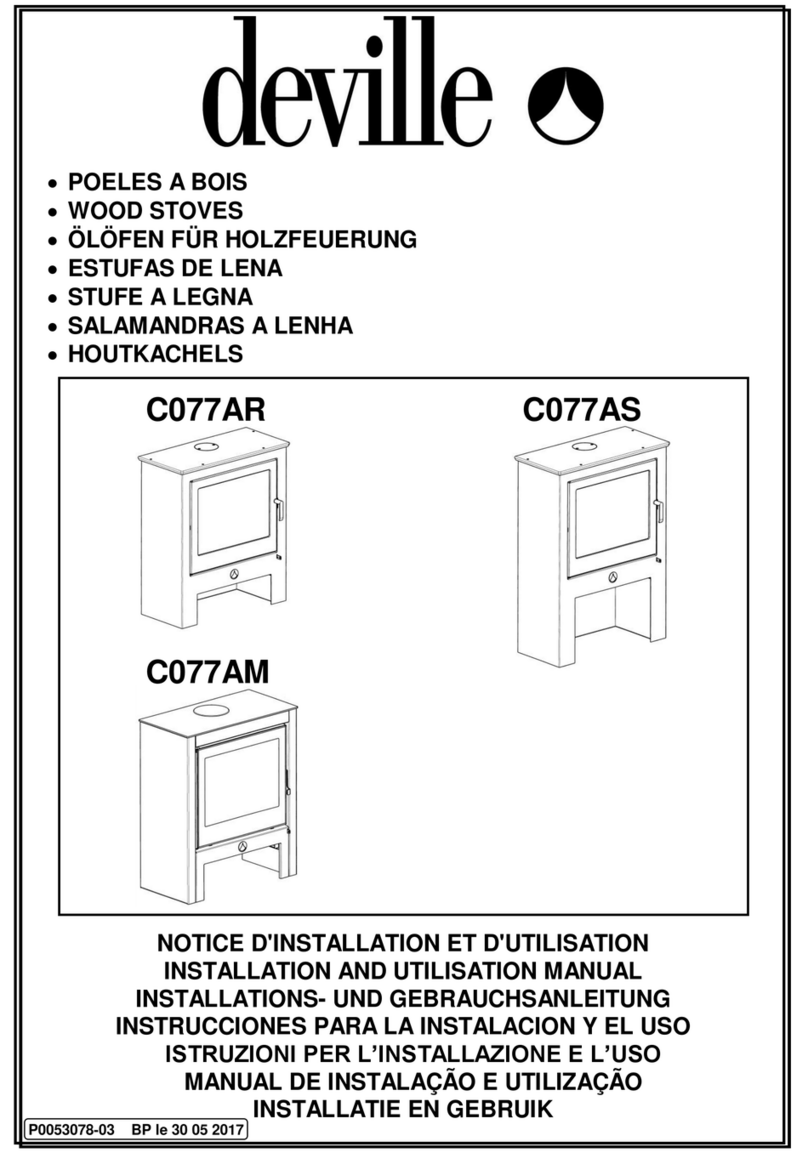
deville
deville C077AR INSTALLATION AND UTILISATION MANUAL
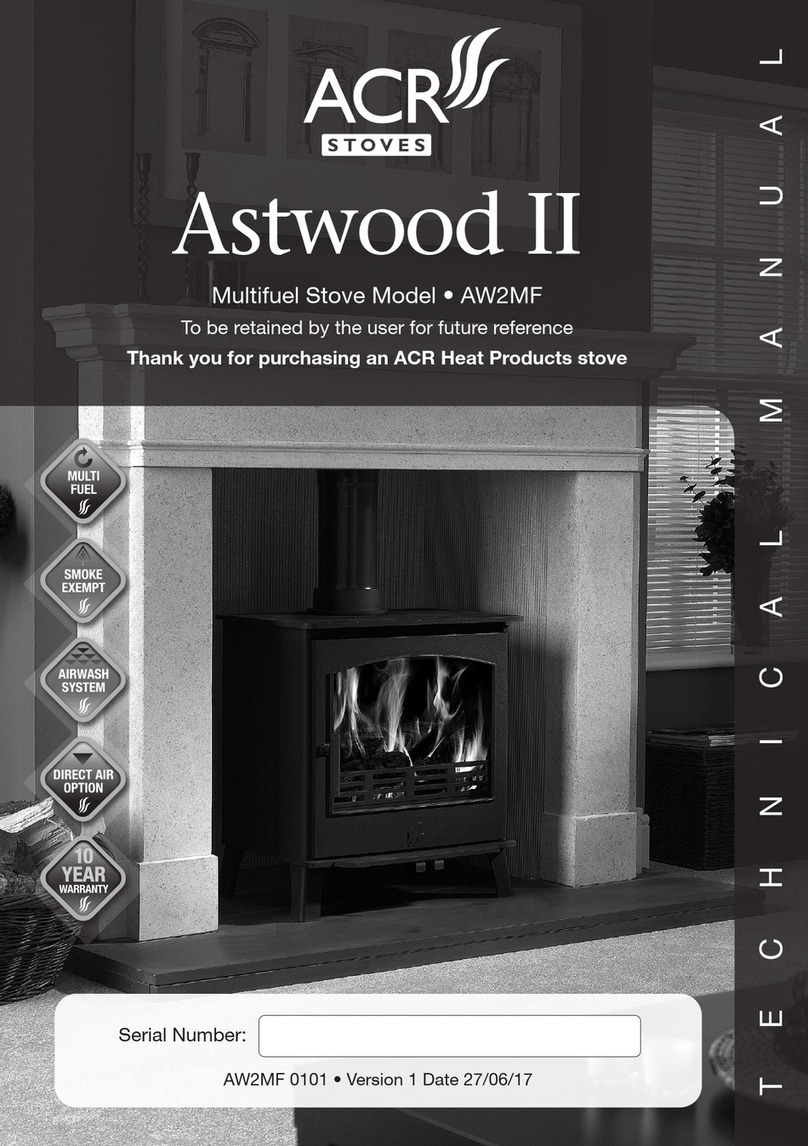
ACR STOVES
ACR STOVES Astwood II Technical manual
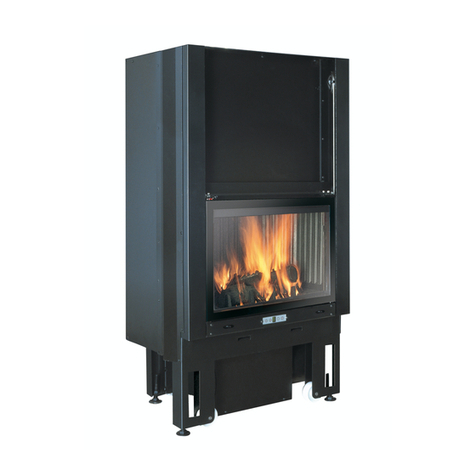
EdilKamin
EdilKamin FORTE UP2 Installation, use and maintenance

Contura
Contura 510 installation instructions
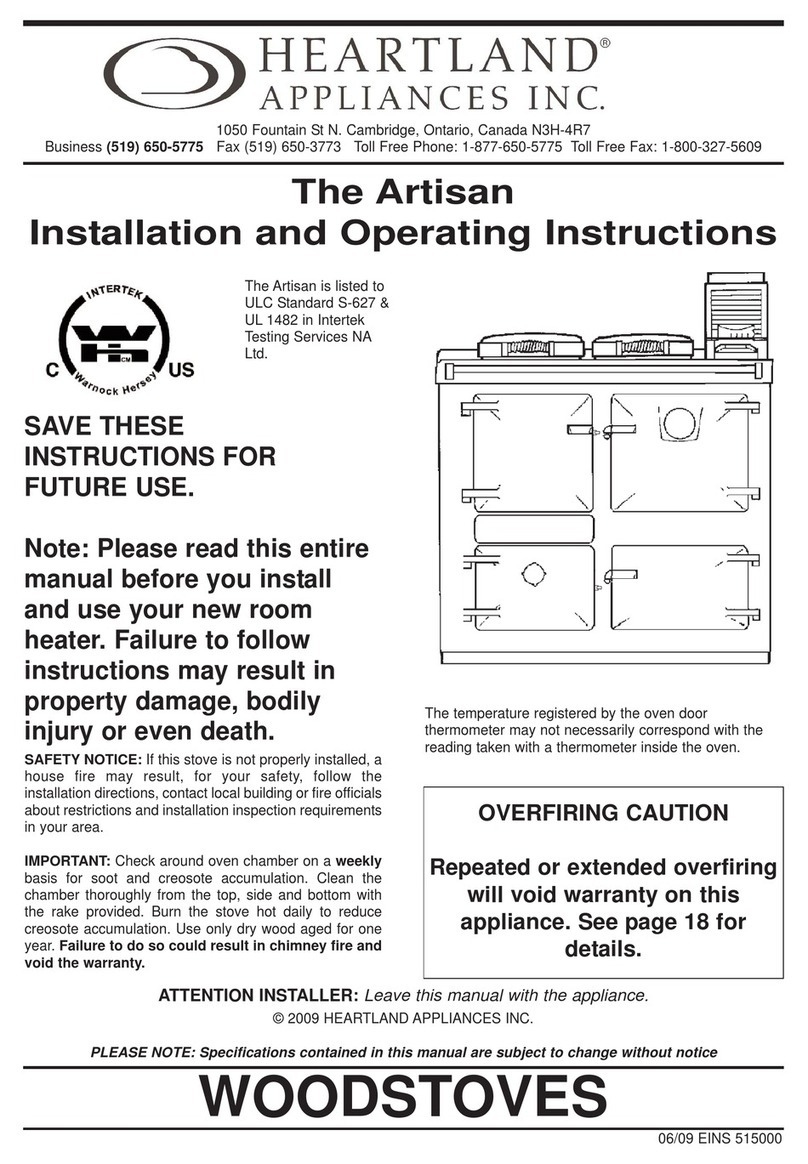
Heartland Appliances
Heartland Appliances The Artisan Installation and operating instructions

Fogo Montanha
Fogo Montanha E601 instruction manual

Vogelzang International
Vogelzang International VG2520-P Owner’s Instruction and Operation Manual

Lopi
Lopi Answer Wood Stove owner's manual

RAIS
RAIS attika NEXO 100 GAS installation guide
